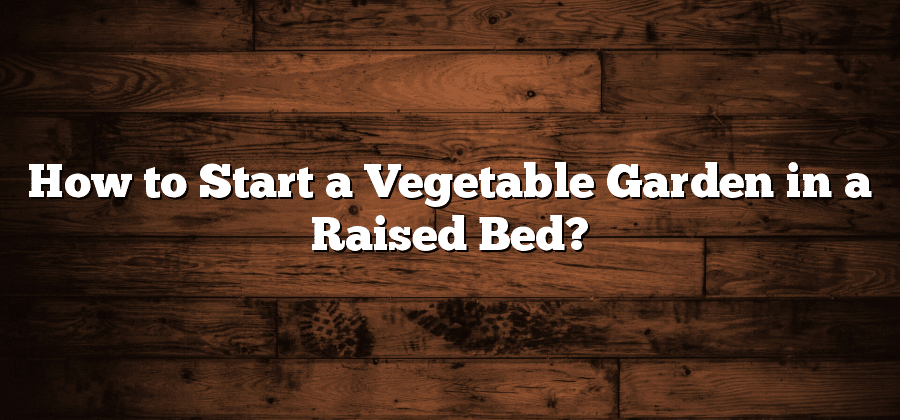Preparing the Raised Bed Soil
To ensure a successful and productive garden in your raised bed, proper preparation of the soil is essential. Start by removing any weeds or grass from the area where you plan to establish your raised bed. This can be done by either pulling them out manually or using a garden hoe to loosen and remove them. It is important to rid the area of any unwanted vegetation as it can compete with your desired plants for nutrients and space.
Once the area is cleared, it is time to amend the soil. Raised beds tend to have better drainage than traditional ground beds, which means that the soil may dry out more quickly. To help retain moisture and provide sufficient nutrients for your plants, add organic matter such as compost or well-rotted manure to the existing soil. Incorporate the organic matter thoroughly by using a garden fork or a tiller, breaking up any clumps and ensuring an even distribution throughout the bed.
By taking the time to properly prepare the soil in your raised bed, you are setting the stage for healthy plant growth and bountiful harvests. The removal of weeds and the addition of organic matter will create an environment that fosters optimal root development and overall plant health. Now that your soil is ready, you can move on to selecting the ideal location for your raised bed.
Choosing the Right Location
One of the most important factors to consider when setting up your raised bed is choosing the right location. The location will greatly impact the success of your vegetable garden, so it is crucial to give it careful thought and consideration. When selecting a spot for your raised bed, it is important to keep in mind that most vegetables require a minimum of six to eight hours of direct sunlight per day. Therefore, it is best to choose an area in your garden that receives ample sunlight throughout the day.
In addition to sunlight, it is important to consider the accessibility of the location. You will want to choose a spot that is easily accessible for weeding, watering, and harvesting. It is also a good idea to select a location that is close to a water source to make watering more convenient. Lastly, consider the soil quality of the area. If your garden soil is of poor quality, it may be beneficial to choose a location where you can add additional soil or amendments to ensure optimal growing conditions for your vegetables. By carefully selecting the right location for your raised bed, you are giving your vegetable garden the best possible chance for success.
Determining the Size of Your Bed
To determine the size of your raised bed, there are a few factors to consider. First, think about the available space in your garden or yard. Measure the area where you plan to place the bed and take note of any obstructions such as trees or structures that might limit its size.
Next, think about the types of vegetables you want to grow in your raised bed. Different vegetables have varying spacing requirements, so you’ll need to take into account how much room each plant will need to thrive. For example, larger plants like tomatoes or peppers will need more space between them, while smaller plants like lettuce or radishes can be planted closer together.
By considering your available space and the specific needs of your chosen vegetables, you’ll be able to determine the optimal size for your raised bed. Remember, it’s always better to start small and gradually expand if needed. This way, you can ensure that you have enough room for your plants to grow and flourish.
Selecting the Ideal Vegetables for Your Raised Bed
When it comes to selecting the vegetables for your raised bed, thorough research and planning are essential. You want to choose vegetables that are well-suited for raised bed gardening and will thrive in the specific conditions of your location. Start by considering the climate and seasonality of your area. Some vegetables, such as tomatoes and peppers, prefer warmer temperatures, while others like lettuce and spinach prefer cooler weather. By understanding the specific needs and preferences of different vegetables, you can ensure a successful and bountiful harvest.
Another factor to consider when selecting vegetables for your raised bed is the available space. Raised beds come in a variety of sizes, so it’s important to choose vegetables that will fit and grow well within the confines of your bed. Take into account the mature size of each vegetable and how much room it will need to spread out. Additionally, consider companion planting techniques, where certain vegetables thrive when planted together while others may compete for resources or attract pests. By carefully selecting a variety of vegetables that can coexist harmoniously in your raised bed, you can maximize the productivity and health of your garden.
Starting Seeds Indoors
Starting seeds indoors is a practical and efficient way to kickstart your vegetable garden. By providing a controlled environment, you can ensure optimal conditions for germination and early growth of your plants. By doing so, you can get a head start on the growing season, allowing for a longer harvest window and potentially higher yields.
When selecting seeds to start indoors, it is important to consider the specific vegetables that will thrive in your raised bed. Choose varieties that are well-suited for the growing conditions in your area, taking into account factors such as temperature, sunlight requirements, and soil type. Additionally, consider the size and maturity rate of the plants, as you want to ensure they have enough space to grow and reach their full potential. By carefully selecting the ideal vegetables for your raised bed, you can maximize your chances of a successful and bountiful harvest.






